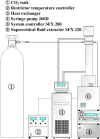Optimization of fucoxanthin extraction obtained from natural by-products from Undaria pinnatifida stem using supercritical CO2 extraction method
- PMID: 36245524
- PMCID: PMC9558218
- DOI: 10.3389/fnut.2022.981176
Optimization of fucoxanthin extraction obtained from natural by-products from Undaria pinnatifida stem using supercritical CO2 extraction method
Abstract
In the recent years, edible brown seaweed, Undaria pinnatifida, has presented beneficial effects, which may be correlated with this species containing major bioactive compounds, such as carotenoids, fatty acids, and phytosterols. Marine carotenoid fucoxanthin is abundantly present in edible Undaria pinnatifida and features strong bioactive activities. The stem of Undaria pinnatifida is very hard to gnaw off and cannot be swallowed; therefore, it is usually discarded as waste, making it an environmental issue. Hence, making full use of the waste stem of Undaria pinnatifida is an urgent motivation. The present study aims to explore the optimal preparation technology of fucoxanthin from Undaria pinnatifida stems using supercritical carbon dioxide methods and provides approaches for the extraction and preparation of bioactive compounds from a waste seaweed part. With the comprehensive optimization conditions applied in this study, the experimental yield of fucoxanthin agreed closely with the predicted value by > 99.3%. The potential of α-amylase and glucoamylase to inhibit bioactive compounds was evaluated. The results demonstrated that the inhibition activity (IC50 value) of α-amylase (0.1857 ± 0.0198 μg/ml) and glucoamylase (0.1577 ± 0.0186 μg/ml) varied with extraction conditions due to the different contents of bioactive components in the extract, especially fucoxanthin (22.09 ± 0.69 mg/g extract). Therefore, this study confirmed supercritical fluid extraction technology to be a useful sample preparation method, which can effectively be used to prepare fucoxanthin from waste marine resources. This method can potentially be applied in functional food and related industries.
Keywords: Undaria pinnatifida stem; fucoxanthin; inhibitory compounds; optimization; supercritical CO2 extraction.
Copyright © 2022 Yin, Niu, Shibata, Liu and Hagiwara.
Conflict of interest statement
The authors declare that the research was conducted in the absence of any commercial or financial relationships that could be construed as a potential conflict of interest.
Figures





Similar articles
-
Extraction of Fucoxanthin Isomers from the Edible Brown Seaweed Undaria pinnatifida Using Supercritical CO2: Effects of Extraction Conditions on Isomerization and Recovery of Fucoxanthin.J Oleo Sci. 2022 Aug 4;71(8):1097-1106. doi: 10.5650/jos.ess22077. Epub 2022 Jul 6. J Oleo Sci. 2022. PMID: 35793974
-
Supercritical carbon dioxide extraction of fucoxanthin from Undaria pinnatifida.J Agric Food Chem. 2013 Jun 19;61(24):5792-7. doi: 10.1021/jf400740p. Epub 2013 Jun 6. J Agric Food Chem. 2013. PMID: 23742680
-
Extraction of fucoxanthin from raw macroalgae excluding drying and cell wall disruption by liquefied dimethyl ether.Mar Drugs. 2014 Apr 30;12(5):2383-96. doi: 10.3390/md12052383. Mar Drugs. 2014. PMID: 24796299 Free PMC article.
-
Therapeutic Prospects of Undaria pinnatifida Polysaccharides: Extraction, Purification, and Functional Activity.Mar Drugs. 2025 Apr 8;23(4):163. doi: 10.3390/md23040163. Mar Drugs. 2025. PMID: 40278284 Free PMC article. Review.
-
Anticancer Effects of Fucoxanthin through Cell Cycle Arrest, Apoptosis Induction, Angiogenesis Inhibition, and Autophagy Modulation.Int J Mol Sci. 2022 Dec 17;23(24):16091. doi: 10.3390/ijms232416091. Int J Mol Sci. 2022. PMID: 36555740 Free PMC article. Review.
Cited by
-
Real time monitoring and evaluation of the inhibition effect of fucoxanthin against α-amylase activity by using QCM-A.Front Nutr. 2023 Jan 12;9:1110615. doi: 10.3389/fnut.2022.1110615. eCollection 2022. Front Nutr. 2023. PMID: 36712503 Free PMC article.
-
Fucoxanthin diminishes oxidative stress damage in human placenta-derived mesenchymal stem cells through the PI3K/Akt/Nrf-2 pathway.Sci Rep. 2023 Dec 27;13(1):22974. doi: 10.1038/s41598-023-49751-5. Sci Rep. 2023. PMID: 38151503 Free PMC article.
-
Biocosmetics Made with Saccharina latissima Fractions from Sustainable Treatment: Physicochemical and Thermorheological Features.Mar Drugs. 2023 Nov 29;21(12):618. doi: 10.3390/md21120618. Mar Drugs. 2023. PMID: 38132939 Free PMC article.
-
Algal Carotenoids: Chemistry, Sources, and Application.Foods. 2023 Jul 20;12(14):2768. doi: 10.3390/foods12142768. Foods. 2023. PMID: 37509860 Free PMC article. Review.
References
-
- Blikra MJ, Altintzoglou T, Løvdal T, Rognså G, Skipnes D, Skåra T, et al. Seaweed products for the future: using current tools to develop a sustainable food industry. Trends Food Sci Technol. (2021) 118:765–76. 10.1016/j.tifs.2021.11.002 - DOI
-
- Lourenço-Lopes C, Fraga-Corral M, Jimenez-Lopez C, Carpena M, Pereira AG, Garcia-Oliveira P, et al. Biological action mechanisms of fucoxanthin extracted from algae for application in food and cosmetic industries. Trends Food Sci Technol. (2021) 117:163–81. 10.1016/j.tifs.2021.03.012 - DOI
-
- Van den Burg SWK, Dagevos H, Helmes RJK, Pernet F. Towards sustainable European seaweed value chains: a triple P perspective. ICES J Mar Sci. (2021) 78:443–50. 10.1093/icesjms/fsz183 - DOI
-
- Rawiwan P, Peng Y, Paramayuda IGPB, Quek SY. Red seaweed: a promising alternative protein source for global food sustainability. Trends Food Sci Technol. (2022) 123:37–56. 10.1016/j.tifs.2022.03.003 - DOI
LinkOut - more resources
Full Text Sources

